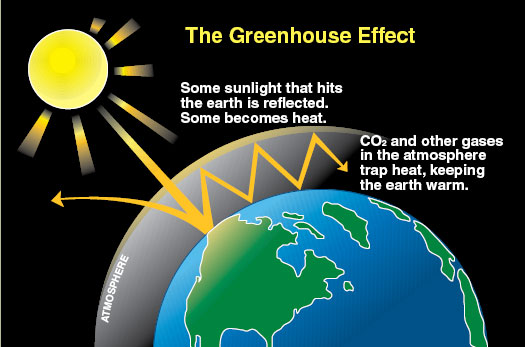
- •What is climate change?
- •Frequently Asked Questions:
- •Are climate change and global warming the same thing?
- •Why is climate change a concern?
- •References:
- •Is climate change really happening?
- •References:
- •What causes climate change and global warming?
- •References:
- •What are greenhouse gases and the greenhouse effect?
- •How is weather different from climate?
- •How is climate change different from ozone?
References:
Intergovernmental Panel on Climate Change – Climate Change 2007: The Physical Science Basis, Summary for Policy Makers; 2007
What are greenhouse gases and the greenhouse effect?
The greenhouse effect occurs as a result of greenhouse gases trapping the sun’s heat and keeping it close to the earth. Anyone who has parked a closed car in the sun for a few hours on a summer day has experienced something like the greenhouse effect. The “greenhouse effect” refers to how gases in the earth’s atmosphere naturally keep the earth warm, similar to how a greenhouse keeps plants warm, hence the name. The earth’s natural greenhouse effect keeps it about 60 degrees warmer than it would be otherwise. This enables us to live comfortably on earth. (NOAA)

Although many “greenhouse gases” occur naturally, human activities have increased their levels and added new ones. Greenhouse gases of concern include carbon dioxide, methane, nitrous oxide, and fluorinated gases. Scientists say that increased levels of these gases are contributing to climate change. Water vapor is the most abundant greenhouse gas, but human activity isn’t considered a direct cause of changes in its concentration. However, a warming atmosphere can trigger changes in water vapor levels. (NOAA) Some examples of activities that contribute to greenhouse gas levels:
Burning fossil fuels – oil, gasoline, gas and coal
Industrial processes and mining
Landfills, septic and sewer systems
Agricultural practices, including fertilizer and manure management
Land use practices, including deforestation
How is weather different from climate?
Weather can change from hour-to-hour, day-to-day, and season-to-season. It may rain for an hour and then become sunny and clear. Weather is what we hear about on the television news every night. It includes wind, temperature, humidity, atmospheric pressure, cloudiness, sunshine and precipitation.
Climate is the average weather for a particular region over a long time period. Climate describes the total of all weather occurring over a long period of years in a given place. This includes average weather conditions, regular weather seasons (winter, spring, summer, and fall), and special weather events (like tornadoes and floods). Climate tells us what it's usually like in the place where you live. Historically, San Diego is known to have a mild climate, New Orleans a humid climate, Buffalo a snowy climate, and Seattle a rainy climate.
A simple way of remembering the difference is that 'climate' is what you expect (cool, wet winters) and 'weather' is what you get (a foggy morning with afternoon sunshine).
How is climate change different from ozone?
Climate change, caused by global warming, is a different problem than the ozone hole.
The ozone hole is a thinning of the stratosphere's ozone layer, which is roughly 9 to 31 miles above the earth's surface. The depletion of this ozone layer is due to man-made chemicals like chlorofluorocarbons (CFCs). A thinner ozone layer lets more harmful ultraviolet (UV) radiation reach the earth's surface. This problem is now slowly improving since countries around the world agreed to stop manufacturing and using CFCs, an international agreement called the Montreal Protocol.
Global warming, on the other hand, is the increase in the earth's average temperature due to the buildup of carbon dioxide and other greenhouse gases in the atmosphere from human activities. Global warming is causing climate change. The 1997 Kyoto Protocol was the initial effort to curb greenhouse gas production. Although many countries have agreed to the Kyoto Protocol, a remaining few, including the United States, have yet to ratify it. However, more than 400 cities in the United States, home to over 66 million people, have committed to the Kyoto goals.
For more information, check out these links:
Climate Change Resources
International Panel on Climate Change (IPCC)
Climate Impacts Group – University of Washington
National Oceanic and Atmospheric Administration (NOAA)
Pew Center on Global Climate Change
